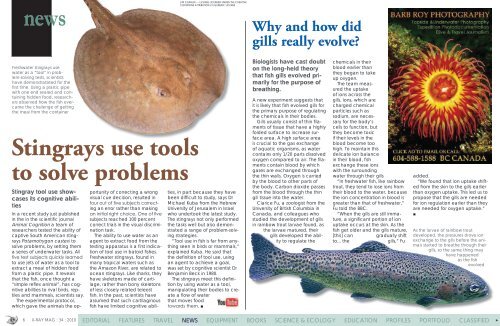Medium resolution version of X-Ray Magazine (96 dpi)
Medium resolution version of X-Ray Magazine (96 dpi)
Medium resolution version of X-Ray Magazine (96 dpi)
Create successful ePaper yourself
Turn your PDF publications into a flip-book with our unique Google optimized e-Paper software.
newsJim Capaldi — license licensed under the CreativeCommons Attribution 2.0 Generic licenseWhy and how didgills really evolve?Freshwater stingrays usewater as a “tool” in problem-solvingtests, scientistshave demonstratated for thefirst time. Using a plastic pipewith one end sealed and containinghidden food, researchersobserved how the fish overcamethe challenge <strong>of</strong> gettingthe meal from the containerStingrays use toolsto solve problemsStingray tool use showcasesits cognitive abilitiesIn a recent study just publishedin the in the scientific journalAnimal Cognition a team <strong>of</strong>researchers tested the ability <strong>of</strong>captive South American stingraysPotamotrygon castexi tosolve problems, by setting thema series <strong>of</strong> underwater tasks. Allfive test subjects quickly learnedto use jets <strong>of</strong> water as a tool toextract a meal <strong>of</strong> hidden foodfrom a plastic pipe. It revealsthat the fish, once thought a“simple reflex animal”, has cognitiveabilities to rival birds, reptilesand mammals, scientists say.The experimental protocol,which gave the animals the opportunity<strong>of</strong> correcting a wrongvisual cue decision, resulted infour out <strong>of</strong> five subjects correctingan error rather than makingan initial right choice. One <strong>of</strong> fivesubjects reached 100 percentcorrect trials in the visual discriminationtask.The ability to use water as anagent to extract food from thetesting apparatus is a first indication<strong>of</strong> tool use in batoid fishes.Freshwater stingrays, found inmany tropical waters such asthe Amazon River, are related toocean stingrays. Like sharks, theyhave skeletons made <strong>of</strong> cartilage,rather than bony skeletons<strong>of</strong> less closely related teleostfish. In the past, scientists haveassumed that such cartilaginousfish have limited cognitive abilities,in part because they havebeen difficult to study, says DrMichael Kuba from the HebrewUniversity <strong>of</strong> Jerusalem in Israelwho undertook the latest study.The stingrays not only performedthe tasks well but also demonstrateda range <strong>of</strong> problem-solvingstrategies.“Tool use in fish is far from anythingseen in birds or mammals,“explained Kuba. He said thatthe definition <strong>of</strong> tool use, usingan agent to achieve a goal,was set by cognitive scientist DrBenjamin Beck in 1980.The stingrays meet this definitionby using water as a tool,manipulating their bodies to createa flow <strong>of</strong> waterthat moves foodtowards them. ■Biologists have cast doubton the long-held theorythat fish gills evolved primarilyfor the purpose <strong>of</strong>breathing.A new experiment suggests thatit is likely that fish evolved gills forthe primary purpose <strong>of</strong> regulatingthe chemicals in their bodies.Gills usually consist <strong>of</strong> thin filaments<strong>of</strong> tissue that have a highlyfolded surface to increase surfacearea. A high surface areais crucial to the gas exchange<strong>of</strong> aquatic organisms, as watercontains only 1/20 parts dissolvedoxygen compared to air. The filamentscontain blood by whichgases are exchanged throughthe thin walls. Oxygen is carriedby the blood to other parts <strong>of</strong>the body. Carbon dioxide passesfrom the blood through the thingill tissue into the water.Clarice Fu, a zoologist from theUniversity <strong>of</strong> British Columbia inCanada, and colleagues whostudied the development <strong>of</strong> gillsin rainbow trout larvae found, asthe larvae matured, theirgills developed the abilityto regulate thechemicals in theirblood earlier thanthey began to takeup oxygen.The team measuredthe uptake<strong>of</strong> ions across thegills. Ions, which arecharged chemicalparticles such assodium, are necessaryfor the body’scells to function, butthey become toxicif their levels in theblood become toohigh. To maintain thisdelicate ion balancein their blood, fishexchange these ionswith the surroundingwater through their gills“In freshwater fish, like rainbowtrout, they tend to lose ions fromtheir blood to the water, becausethe ion concentration in blood isgreater than that <strong>of</strong> freshwater,”Fu told the BBC.“When the gills are still immature,a significant portion <strong>of</strong> ionuptake occurs at the skin. As thefish get older and the gills mature,[this] cangradually shiftto... thegills,” Fuadded.“We found that ion uptake shiftedfrom the skin to the gills earlierthan oxygen uptake. This led us topropose that the gills are neededfor ion regulation earlier than theyare needed for oxygen uptake.”■As the larvae <strong>of</strong> rainbow troutdeveloped, the pressures drove ionexchange to the gills before the animalsstarted to breathe through theirgills, so the same thing mayhave happenedas the fishevolved6 X-RAY MAG : 34 : 2010 EDITORIAL FEATURES TRAVEL NEWS EQUIPMENT BOOKS SCIENCE & ECOLOGY EDUCATION PROFILES PORTFOLIO CLASSIFIED
















